When it comes to content, your blog is a canvas for all your creative thoughts. But how do you ensure every brushstroke on this digital canvas captures the attention of your audience?
The answer isn’t a one-size-fits-all solution; it’s variety! Diverse content not only keeps your readers engaged but also ticks the search engine optimization boxes that help your blog reach new heights.
This post is not just about throwing around the idea of diverse content. We’ll dig into specific blog post examples that will inspire you with incredible content for your own blog.
Whether you’re a seasoned blogger looking for new inspiration or a fresh creator eager to make your voice heard, this article is going to be a goldmine.
Stick around till the end, where you’ll be treated to a free blog post template, ready to fill with your revolutionary words.
Here are some popular blog examples from successful blogs:
- Listicle: What to Do When You’re Bored: 265 Ideas for Every Mood by The Every Girl
- Tutorial: How to Start a Blog by Create and Go
- Personal Story: Living in a Van: Best Parts of Campervan Life by Two Wandering Soles
- Recipe Post: Mandarin Orange Chicken Salad by Eating Bird Food
- Product Review: The Monthly Gnaw Box Subscription by The Dog People
But we’ll dive much deeper into these and more throughout this blog post!
What is a Blog Post?
Before we dive into specific blog post examples, let’s first define what a blog post actually is. A blog post is a piece of online content written and published on a blog website. It typically consists of text, images, and/or videos that convey information or ideas to the reader.
Blog posts can cover a wide range of topics, from personal experiences to educational blog posts or product reviews. The possibilities are endless, and that’s what makes blogging so exciting!
How Long Should a Blog Post Be?
The length of a blog post can vary depending on the topic and purpose. Some bloggers prefer shorter posts (300-500 words) that are straight to the point, while others opt for longer, more in-depth blog posts (1500+ words).
Ultimately, the length should be determined by what best serves your content and captures your audience’s attention.
5 Key Elements Most Blog Posts Should Have
Before jumping into the examples, it’s crucial to understand what makes up an effective blog post. While formats and content will vary greatly, the following elements are typically present in the most successful posts:
1. Compelling Title
Blog post titles are the first point of contact readers have with your content. It’s what makes the difference between a potential reader scrolling past or deciding to click through to your post.
An effective title should be clear, engaging, and reflective of the content. You can also use headline analyzers to check your blog post titles before publishing them.

Here are a few elements that make up a great blog post title:
- Keywords: Incorporating relevant keywords in your title can help with SEO and make it easier for readers to find your post.
- Emotion: Titles that evoke emotion, whether positive or negative, tend to generate more clicks. This is because people are naturally drawn to content that makes them feel something.
- Numbers: Using numbers in your title can make it stand out and give readers a clear idea of what to expect from your post. This could include lists, statistics, or any other numerical information.
2. Captivating Introduction
After the title, the introduction is your next opportunity to hook readers and keep them engaged. A captivating introduction should pique the reader’s interest and give them a taste of what’s to come, without giving away everything.
Here are some ways to make your introduction stand out:
- Start with a question: Asking a thought-provoking question can encourage readers to continue reading for answers.
- Use storytelling: Narratives can be effective in drawing readers in and making them emotionally invested in your post.
- Include statistics or data: Using relevant statistics or data can add credibility to your content and make it more engaging for readers.
3. Quality Content
It goes without saying that the meat of your blog post should be high-quality, informative, and valuable to your audience. This is where you can let your creativity shine and provide unique insights, ideas, or tips.
Here are some tips to make sure your content is top-notch:
- Research: Whether it’s through interviews, surveys, or online sources, conducting thorough research will give your post credibility and depth.
- Include examples: Real-life examples or case studies can make your content relatable and show the practical application of your ideas.
- Keywords: Keyword research is also important to make sure that you are incorporating relevant keywords throughout your post. This will help improve SEO and make the blog page more discoverable for readers in search engines.

4. Engaging Visuals
Visuals can make a significant impact on the engagement levels of your blog post. They break up text and add interest, making it easier for readers to digest your content.
Here are some ideas for incorporating visuals in your blog post:
- Images: Use high-quality images related to your content to capture the reader’s attention.
- Infographics: Infographics are a great way to present data or complex information in a visually appealing and easy-to-understand format.
- Videos: Including videos in your post can add a dynamic element and give readers a break from reading.
5. Call to Action
A call to action (CTA) is a sentence or phrase that encourages readers to take a specific action after reading your post. This could be subscribing to your newsletter, leaving a comment, or sharing the post on social media.
Here are some tips for creating an effective CTA:
- Be clear and concise: Your CTA should be straightforward and tell readers exactly what you want them to do.
- Create urgency: Using urgency words like “now” or “limited time offer” can motivate readers to take action before it’s too late.
- Offer something valuable: Give readers a reason to follow your CTA, whether it’s exclusive content or a chance to win a prize.
Why Diversify Your Content?
Content variety isn’t just about keeping things fresh; it has tangible benefits that can take your blog to the next level.
- Increased Engagement: Different people enjoy different types of content. By including a range of formats, you’re more likely to capture the interest of various audience segments.
- Broader Audience Reach: Someone may stumble upon your in-depth case study, while another reader may be drawn to your personal story. Each is a potential new follower or subscriber.
- Improved SEO: Certain post types, such as how-to guides or listicles, are naturally more search engine-friendly. They use headers, lists, and keywords that make it easier for Google to understand and rank your content.
12 Popular Types of Blog Posts
Now that we’ve covered the essential elements of a blog post, let’s explore different types of blog posts you can use to keep your content diverse and engaging.
- Listicles: Posts that revolve around numbered lists, usually with an eye-catching title like “10 Tips for…” or “5 Reasons Why…”.
- How-To Guides: Step-by-step guides that provide readers with valuable information and actionable advice.
- Case Studies: Articles that analyze a real-life situation or problem and offer insights and solutions.
- Opinion Pieces: Blog posts where the author shares their personal opinion on a particular topic. These can be thought-provoking and spark discussions among readers.
- Interviews: Conducting interviews with experts or influential individuals in your niche can add credibility to your content and offer unique perspectives.
- Product Reviews: Articles that review a product or service, providing readers with unbiased information and recommendations.
- Guest Posts: Posts written by guest authors, often experts in their field, to provide fresh perspectives and insights for your audience.
- Personal Stories: Sharing personal experiences or stories can create a connection with readers and make your content more relatable.
- Roundup Posts: Articles that compile information or tips from various sources, often with a specific theme. These can save readers time and provide them with diverse perspectives.
- Tutorials: Similar to how-to guides, tutorials are usually long-form content that provide step-by-step instructions for a certain task or skill.
- Predictions and Trends: Blog posts that explore upcoming trends or predict the future of a certain industry can be both informative and intriguing for readers.
- Comparison Posts: Articles that compare two or more products, services, or ideas can help readers make informed decisions and showcase your expertise in a particular niche.
- Sponsored Posts: Blog posts written in collaboration with a brand or company, usually promoting their products or services. These should always be disclosed to readers as sponsored content.
As you can see, there are endless possibilities for creating engaging and diverse blog posts. Experiment with different types and find what works best for your audience and niche.
18 Blog Post Examples for Various Niches
Now that we’ve covered the essential elements of a successful blog post, let’s dive into some specific examples. Here are 18 blog post ideas for different niches and industries:
Lifestyle Blog Post Examples
Lifestyle bloggers have the unique opportunity to cover a wide array of topics that resonate with their daily activities, interests, and personal experiences.
Lifestyle blog post ideas may include:
- Home Decor and Organization: Posts that offer ideas on how to beautify and organize living spaces, showcasing before-and-after transformations or DIY home projects.
- Fashion and Beauty Tips: Sharing the latest fashion trends, outfit ideas, makeup tutorials, and beauty product reviews.
- Health and Wellness: Articles that focus on mental health, fitness routines, diet plans, and holistic wellness practices.
- Travel Diaries: Detailing travel adventures, destination guides, travel tips, and packing essentials for various locations around the globe.
- Cooking and Recipes: Featuring favorite recipes, cooking tips, meal prep ideas, and dietary advice for different lifestyles.
- Personal Development: Posts that encourage self-improvement, motivation, productivity hacks, and goal-setting techniques.
- Family and Relationships: Sharing experiences and advice on parenting, marriage, friendship, and navigating personal relationships.
- Hobby and Leisure Activities: Exploring hobbies like photography, reading, gardening, or crafting, offering insights and how-tos for enthusiasts.
Lifestyle blogs are known for spanning across any and all topics and have some of the most diversified blog content of any niche.
Example 1, Listicle: What to Do When You’re Bored: 265 Ideas for Every Mood by The Every Girl

This post offers readers a comprehensive list of activities to do when feeling bored, categorized by different types of activities such as “Outdoor” and “Relaxed” and “Creative.”
The post is very well organized and structured and includes a lot of opportunities for internal links and links to affiliate programs for extra earning potential.
Listicles provide great opportunities to make money with affiliate marketing because they allow for a variety of recommendations around different affiliate programs.
Additionally, the post’s catchy title and practical content make it highly shareable on social media, attracting more traffic to the blog.
Example 2, Sponsored Post: The Perfect Beard Care Routine by Twenty First Century Gent
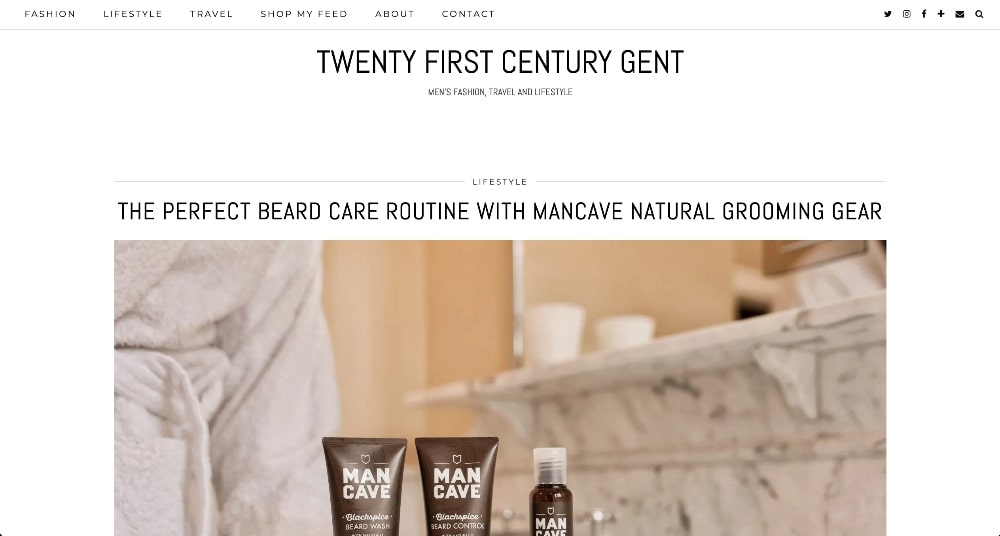
This post is a perfect example of sponsored content done right. Ben, the blogger behind this website, collaborated with a brand to create a detailed guide on beard care, incorporating the sponsor’s products and providing readers with valuable tips and recommendations.
The blog post is well-written and informative, making it feel like an unbiased review rather than an advertisement. It also includes high-quality images and links to purchase the recommended products.
Through this sponsored post, the blogger not only earns revenue from the collaboration but also provides value to their audience with valuable content.
Business Blog Post Examples
Business and entrepreneurship blogs focus on providing tips, advice, and insights for professionals in various industries.
Business blog content may include:
- Marketing Strategies: Sharing effective marketing tactics, such as social media advertising, email campaigns, content marketing, and SEO.
- Finance and Investment: Offering financial advice for business owners, investors, or individuals looking to increase their wealth.
- Leadership and Management: Providing tips on effective leadership styles, team management strategies, and productivity techniques.
- Industry News and Analysis: Keeping readers updated with the latest trends in a particular industry or market analysis and insights.
- Entrepreneurial Journeys: Sharing personal experiences, success stories, and challenges faced by entrepreneurs to inspire and educate readers.
- Productivity Tools and Apps: Introducing new tools, apps, or software that can help businesses streamline their processes and increase efficiency.
- Client Case Studies: Showcasing success stories of clients or customers using the business’s products or services, highlighting their achievements and how the company contributed to them.
- Legal and Regulatory Compliance: Offering advice on navigating legal procedures and regulations for businesses, such as tax laws, contracts, and licenses.
Business blogs should focus on providing valuable information to readers while also promoting the blogger’s expertise and services. Incorporating case studies, industry news, and practical tips can help establish the blog as a go-to source for professionals in their field.
Example 3, Tutorial: How to Start a Blog by Create and Go
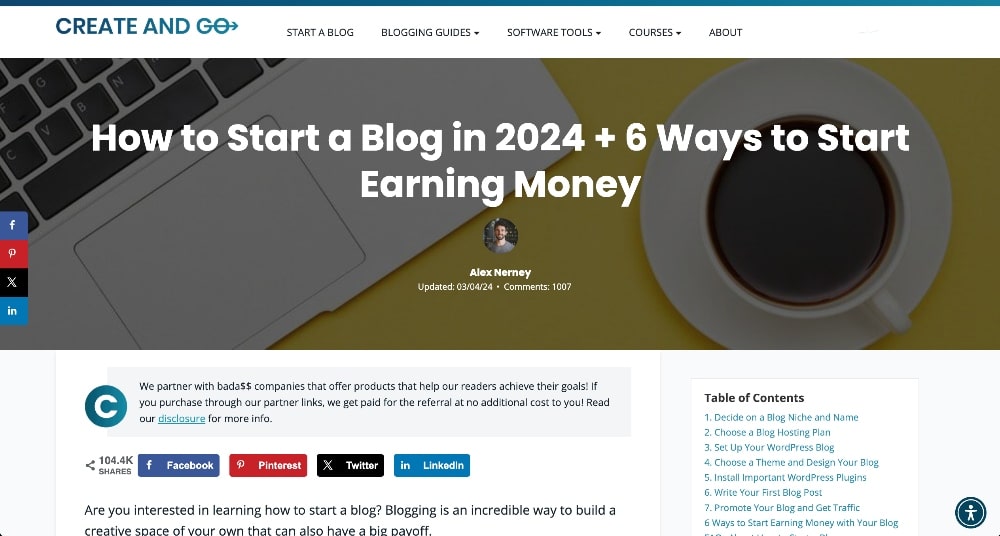
This tutorial that we wrote is a great blog post example of a comprehensive guide or tutorial. It covers everything you need to know to start a blog, from choosing a niche and setting up the website to creating content and making money with it.
The post is very detailed and includes step-by-step instructions, screenshots, and video tutorials to make it easy for beginners to follow along.
Additionally, we incorporate affiliate links throughout the post for hosting services and blogging tools, making it a great opportunity for monetization.
Overall, this tutorial not only provides valuable information to readers but also promotes the blogger’s expertise and recommended resources.
Example 4, Comparison Review: Empower Vs. Fidelity: Ultimate Retirement Planning by The Savvy Couple

This blog post example by Kelan and Brittany Kline compares two popular retirement planning services, Empower and Fidelity, providing readers with a detailed analysis of their features, fees, and customer reviews.
The post includes a clear table for visual comparison and incorporates personal experiences and opinions from the authors to give a more unbiased review.
Comparison posts are great opportunities to make money on affiliate programs because the personal opinions of the writers can help steer the readers toward (or away from) a particular product and ultimately help them make a decision.
By offering a thorough comparison, this post not only provides valuable information to readers but also establishes the blog as a trusted source for financial advice.
Travel Blog Post Examples
Travel blogs are all about sharing personal experiences, tips, and recommendations for traveling to different destinations.
Some travel blog post ideas include:
- Destination Guides: Detailed guides on specific places or cities, providing information on the best attractions, accommodations, food options, and transportation.
- Budget Travel Tips: Sharing tips and tricks for traveling on a budget, such as finding cheap flights, accommodations, and activities.
- Adventure Travel: Highlighting unique and thrilling experiences, such as hiking, camping, or extreme sports.
- Cultural Immersion: Offering insights into local customs, traditions, and lifestyles to help travelers better understand and appreciate the places they visit.
- Solo Travel: Providing tips for solo travelers on safety measures, budgeting, and finding solo-friendly activities.
- Travel Photography: Showcasing stunning travel photos and offering tips on how to capture the perfect shot while traveling.
- Food and Drink Experiences: Sharing recommendations for must-try local dishes and drinks in different destinations.
- Travel Itineraries: Providing suggested itineraries for specific trips, including transportation, accommodations, and activities to help travelers plan their trips.
Travel blogs are not only helpful for those planning a trip but also provide inspiration and entertainment for those who love to travel.
Personal stories, beautiful photos, and detailed guides make for engaging content that can attract both readers and potential sponsors or partnerships.
Example 5, Personal Story: Living in a Van: Best Parts of Campervan Life by Two Wandering Soles
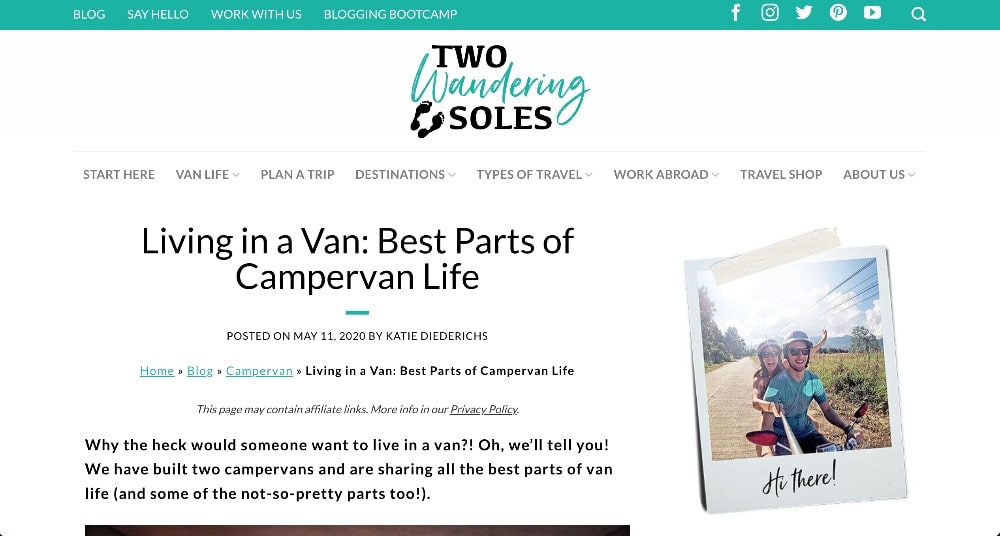
This blog post example by Katie and Ben of Two Wandering Soles shares their personal experience of living and traveling in a van for over two years.
They highlight the best parts of campervan life, including freedom, adventure, and simplicity, while also acknowledging the challenges they faced along the way.
The post includes stunning photos from their travels and provides helpful tips for anyone considering van life.
Personal stories are a great way to connect with readers and inspire them to pursue their own travel dreams. Sharing pain points, in particular, can show vulnerability and make your content more relatable.
This article is also a great piece of pre-sale content for their courses about getting started with van life!
Example 6, How-To Guide: How to Become a Travel Photographer by Expert Vagabond

This blog post by Matt Karsten, the creator of Expert Vagabond, is a detailed guide on how to become a professional travel photographer.
The post covers everything from equipment and camera settings to networking and selling photos for profit.
Matt also includes stunning examples of his own photography throughout the post, demonstrating his expertise and success in this field.
How-to guides are a great way to provide valuable information and establish the blogger as an expert in their niche. Including personal experience and examples can also make the content more relatable and engaging for readers.
This post is also a great opportunity for monetization, as it promotes Matt’s photography courses and workshops, as well as affiliate links for recommended equipment.
Food and Recipe Blog Post Examples
Food and recipe blogs are all about sharing delicious recipes, cooking tips, and food-related content.
Some examples of food and recipe blog post ideas include:
- Recipe Collections: Sharing a collection of recipes that fit a specific theme or dietary preference (e.g., 30-minute meals, vegan dishes).
- Cooking Tips and Techniques: Offering tips and tricks for cooking, baking, or meal prep to help readers improve their skills in the kitchen.
- Restaurant Reviews: Sharing personal experiences and recommendations for restaurants, cafes, and food trucks in different locations.
- Food Photography Tips: Providing insights on how to take mouthwatering photos of food for social media or a blog.
- Seasonal Recipes: Sharing recipes that feature seasonal produce or flavors.
- Family-Friendly Meals: Providing easy and tasty meal ideas for busy families.
- Healthy Living Tips: Offering tips and advice on how to maintain a healthy lifestyle through food choices and cooking habits.
Food blogs can be a great resource for anyone looking to expand their kitchen skills or find new meal ideas. From delicious recipes to helpful tips, these blogs offer valuable information and inspiration for any food lover.
Example 7, Recipe Post: Mandarin Orange Chicken Salad by Eating Bird Food
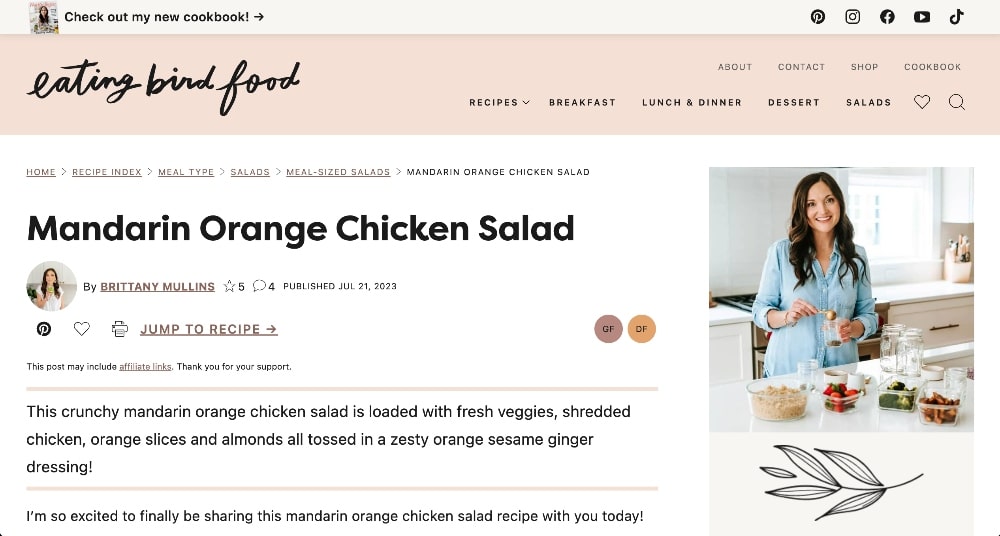
This recipe post by Brittany Mullins of Eating Bird Food features a colorful and flavorful Mandarin Orange Chicken Salad.
The post includes step-by-step instructions, photos for each step, and nutritional information for the dish.
Brittany also shares some tips for meal prep and variations to make the recipe vegan or gluten-free.
Recipe posts are an excellent way to provide valuable content and promote products or services, such as meal planning services or kitchen tools. In Brittany’s case, they also provide a great opportunity to promote her cookbook.
Example 8, Trends: What is Fermentation? A Beginner’s Guide by The Homesteading Family
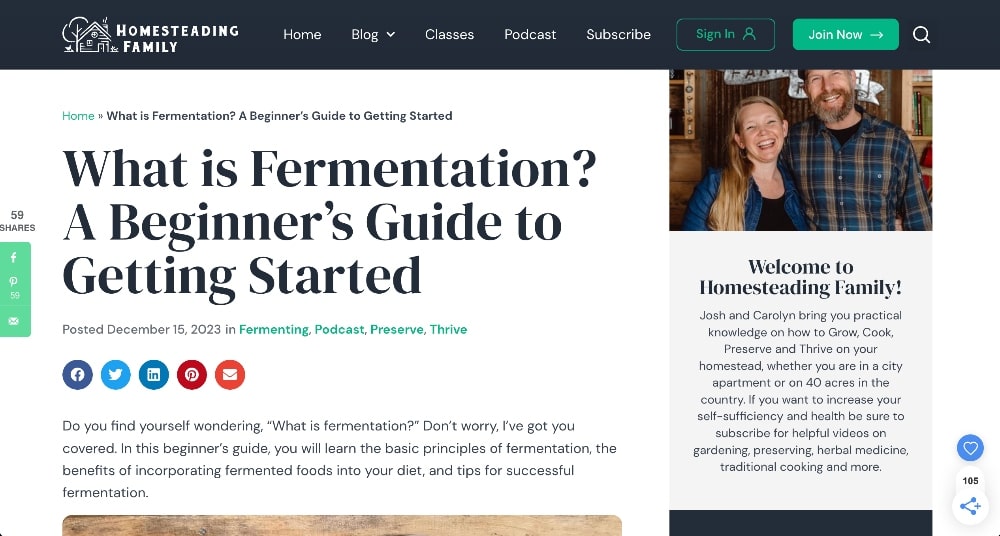
This blog post by Brad and Christa of The Homesteading Family is a comprehensive guide to fermentation, including what it is, how it works, and different methods for preserving food through fermentation.
Fermenting foods has become very popular in recent years, so this also makes this a great blog post example of a trend.
When you write blog posts about new trends, you take advantage of higher amounts of traffic for increased interest in these topics. You can also potentially rank faster for these topics in search engines if you start writing about them before the competition does.
Pet Blog Post Examples
Pet blogs are all about sharing stories, tips, and information related to our furry best friends.
Pet blog content often includes:
- Adoption Stories: Sharing personal experiences of adopting a new pet and how it has changed their life.
- Training Tips: Offering advice and techniques for training dogs or cats.
- Breed Spotlights: Highlighting different breeds of cats or dogs and their unique characteristics.
- DIY Pet Projects: Sharing tutorials for making pet toys, treats, or accessories.
- Health and Wellness: Providing information on how to keep pets healthy and happy, including nutrition tips and preventative care strategies.
- Traveling with Pets: Offering advice and recommendations for traveling with pets, from road trips to flying.
- Pet Product Reviews: Sharing honest reviews of pet products and services, such as food, grooming tools, or pet-friendly hotels.
From heartwarming stories to helpful tips, pet blogs are a great resource for all things related to our beloved pets. They can also be a great platform for connecting with other animal lovers and promoting products or services for pets.
Example 9, Product Review: The Monthly Gnaw Box Subscription by The Dog People
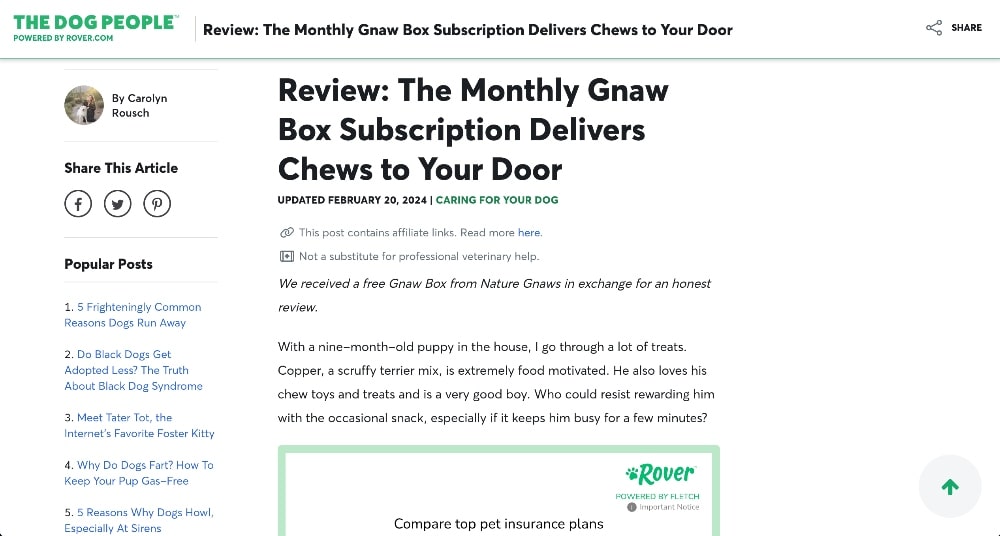
This blog post by the team at Rover.com is a review of The Monthly Gnaw Box, a subscription box filled with toys and treats for dogs.
The post includes an in-depth review of the products, as well as photos and videos featuring dogs enjoying their Gnaw Boxes.
Product reviews are a great way to provide valuable information to readers and promote products or services. They can also help to build trust and establish the blogger as an expert in their niche.
Example 10, Round-Up: 10 Best Cat Foods – Reviews & Top Picks by Pet Keen
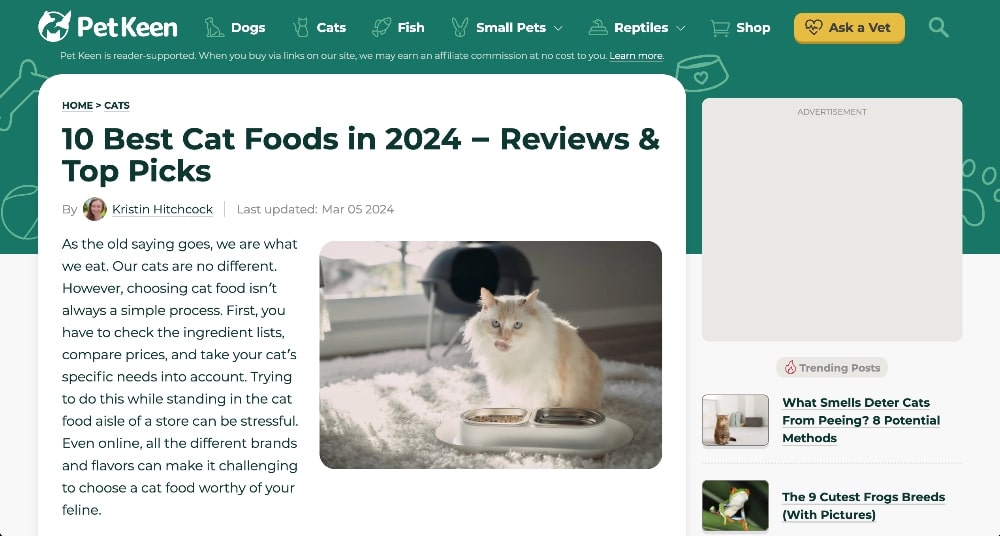
Pet Keen’s round-up post of the 10 best cat foods is a great example of providing valuable information to readers while also promoting products.
The blog post features short reviews and ratings for each cat food, as well as links to purchase them on Amazon.
Round-up posts are an effective way to showcase multiple products or services in one post, making it easier for readers to compare and make purchasing decisions. They also allow for opportunities to earn affiliate income through product promotions.
Beauty and Fashion Blog Post Examples
Beauty and fashion blogs are all about sharing style inspiration, product recommendations, and beauty tips. Some examples of blog post topics in this niche include:
- Trend Spotting: Writing about the latest fashion trends, hairstyles, or makeup styles.
- Makeup Tutorials: Sharing step-by-step instructions for achieving different makeup looks.
- Fashion Hacks: Offering tips and tricks for looking stylish on a budget or with limited time.
- Skincare Routine: Sharing personal skincare routines and product recommendations.
- Beauty Product Reviews: Writing honest reviews of beauty products, such as makeup, skincare, or haircare items.
- Outfit of the Day (OOTD): Showcasing different outfits and providing styling tips.
- Fashion Week Coverage: Writing about the latest fashion shows and collections from top designers.
From everyday style to high-end fashion, beauty and fashion blogs cover a wide range of topics. They can also be a great platform for promoting products through affiliate links or sponsored posts.
Example 11, Product Reviews: My Top Picks From Beauty Pie’s Summer Drop by The Anna Edit

This blog post by Anna of The Anna Edit features her top picks from Beauty Pie’s summer drop.
These types of blog posts are usually created to resonate with the correct audience and help sell products, rather than be heavily SEO-optimized to reach new audiences.
Your current audience will know and trust you a lot better than someone new, and they are usually the ones taking your recommendations and buying products.
This blog post example is fairly basic with product descriptions and affiliate links, as well as links to purchase them through Beauty Pie’s membership program.
Example 12, Opinion/Trend/Product: Three Ways to Style a White Blazer by Wendy’s Lookbook

This blog post example by Wendy of Wendy’s Lookbook showcases three different ways to style a white blazer, providing inspiration for incorporating this staple piece into various outfits.
These types of posts can really fall into a variety of different categories, including personal opinion pieces, recent trends, and product reviews.
In this post, Wendy gives her personal opinion on how to style white blazers, which could also be considered a recent trend and includes affiliate links for various white blazers.
Parenting Blog Post Examples
Parenting blogs, such as mom blogs and dad blogs, are all about sharing advice, tips, and stories related to raising children.
Some popular blog post ideas in this niche include:
- Pregnancy Journals: Documenting the journey of pregnancy and sharing personal experiences.
- Child Development Milestones: Providing information on what to expect at each stage of a child’s development.
- Parenting Hacks: Offering tips and tricks for making parenting easier and more enjoyable.
- Family Activities: Sharing ideas for fun and educational activities to do with children.
- Product Reviews: Writing honest reviews of products for parents and children, such as strollers, car seats, or toys.
- Parenting Support: Providing resources and support for parents facing challenges such as postpartum depression or parenting a child with special needs.
- Meal Planning for Families: Sharing meal planning tips and recipes for busy families.
Parenting blogs can also be a great platform for building a community and connecting with other parents who may be going through similar experiences.
Example 13, Listicle: 4 Commonly Missed Signs of Childhood OCD by Parent From Heart
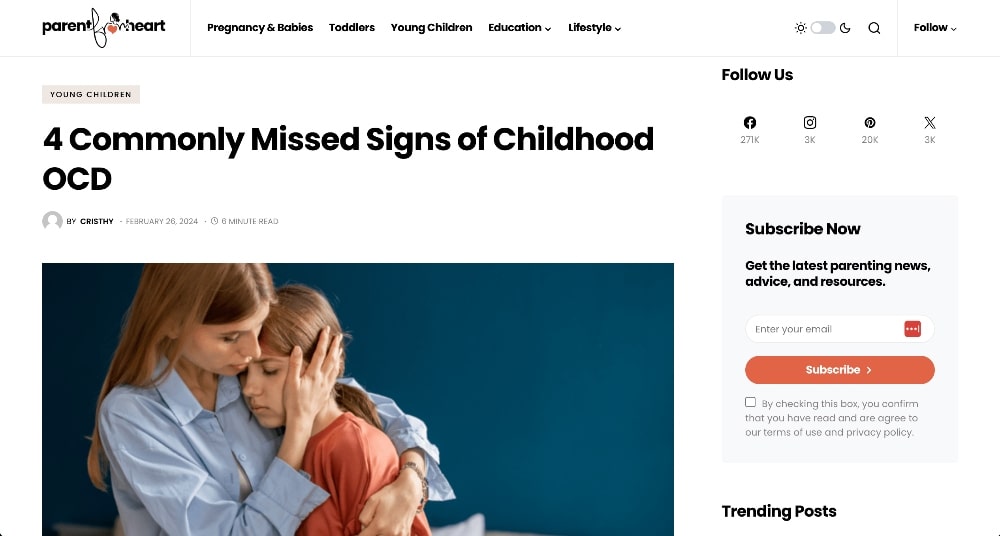
This blog post by Parent From Heart shares four commonly missed signs of childhood OCD, providing important information for parents to recognize and address potential symptoms in their own children.
Listicle posts are a popular format for parenting blogs, as they provide easily digestible information for busy parents. They can also be optimized for SEO by targeting specific keywords related to the topic.
Example 14, Opinion Piece: Why are Preschool Programs Becoming Less Effective? by Not Just Cute

This blog post by Not Just Cute delves into the topic of why preschool programs may be becoming less effective, offering insights and opinions on potential reasons.
Opinion pieces can spark conversations and debates within the parenting community, making them a powerful way to engage readers and build a loyal audience. They can also be a great way to share personal experiences and offer advice.
Technology Blog Post Examples
Technology blogs, also known as tech blogs, cover a wide range of topics related to the latest gadgets, software, and advancements in the world of technology.
Technology blog content often includes:
- Product Reviews: Writing honest reviews of new tech products, such as smartphones, laptops, or smart home devices.
- How-To Guides: Providing step-by-step instructions for using different software or devices.
- Tech News: Sharing updates and information on the latest technology innovations and trends.
- Gaming Reviews: Offering in-depth reviews of new video games and gaming equipment.
- Troubleshooting Tips: Providing solutions for common tech issues and offering troubleshooting advice.
- Opinions/Editorials: Writing opinion pieces on current events and controversies in the tech industry.
- Tech Tips and Tricks: Sharing little-known tips and tricks for optimizing technology usage and productivity.
Tech blogs can serve as a valuable resource for readers looking to stay informed and up-to-date on the ever-changing world of technology.
Example 15, News: Airbnb Finally Bans Creepy Indoor Cameras by Gizmodo

This news post by Gizmodo reports on Airbnb’s updated policies, banning the use of indoor cameras after multiple incidents of hosts secretly filming guests.
News posts can be a great way for tech blogs to stay relevant and provide valuable information to their readers. They can also attract new audiences through SEO optimization and social media sharing.
Example 16, How-To Guide: How to Type in Multiple Languages in a Word Document by How-To Geek
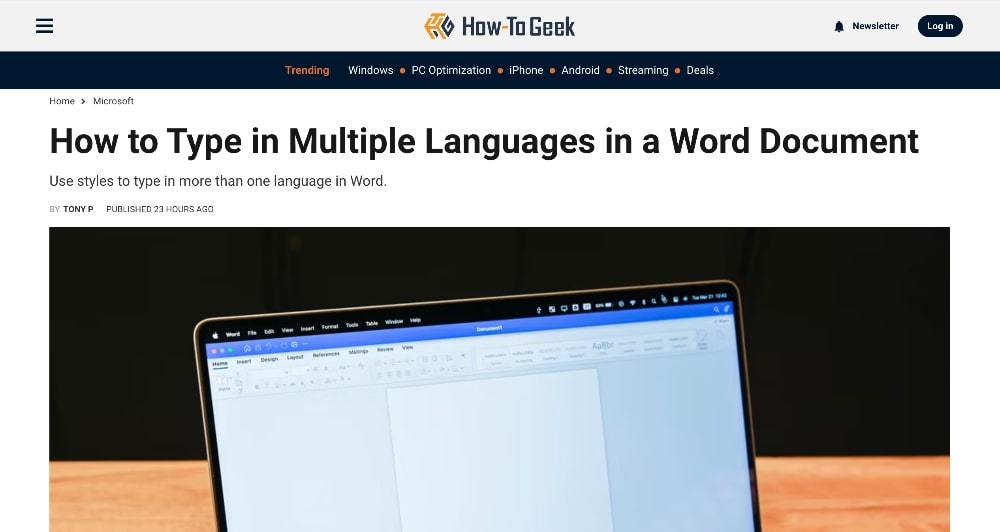
This how-to guide by How-To Geek provides step-by-step instructions for typing in multiple languages within a Word document, offering a useful solution for those who need to communicate in different languages.
How-to guides are a popular format for tech blogs, as they offer practical and actionable advice for readers to try out themselves. They can also attract new traffic through targeted keywords and SEO optimization.
Photography Blog Post Examples
Photography blogs cover various aspects of the art and business of photography, including tips, techniques, gear reviews, and inspirational showcases.
Some successful blog post topics in this niche include:
- Photo Editing Tutorials: Providing step-by-step instructions for editing photos using different software.
- Gear Reviews: Writing honest reviews of cameras, lenses, and other photography equipment.
- Photography Techniques: Sharing tips and tricks for mastering composition, lighting, and other aspects of photography.
- Client Sessions: Offering insights into the process and experience of working with clients as a professional photographer.
- Travel Photography: Showcasing stunning photographs from different travel destinations around the world.
- Inspirational Stories: Sharing stories and experiences that inspire and motivate others in their photography journey.
A good photography blog can serve as a source of inspiration, education, and community for both amateur and professional photographers alike.
Example 17, Product Comparison: Tripod vs Monopod: Which Should You Use? by Digital Photography School
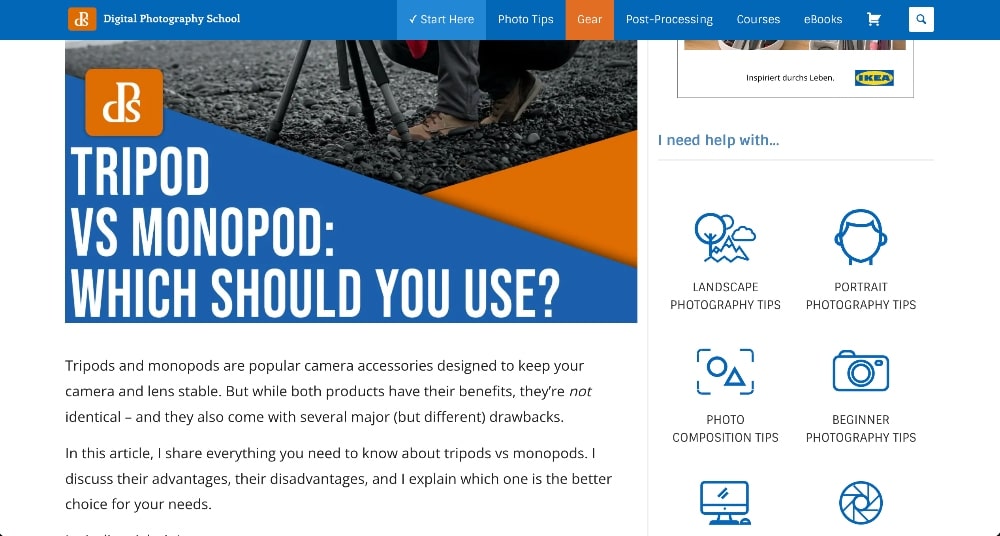
This blog post by Digital Photography School compares the advantages and disadvantages of using a tripod versus a monopod, helping readers make an informed decision for their photography needs.
Product comparisons can be an effective way for photography blogs to provide valuable information to their audience while also promoting affiliate products.
Example 18, Tutorial: How to Edit Photos in Lightroom by Expert Photography

This tutorial by Expert Photography offers a comprehensive guide to using Lightroom for photo editing, catering to both beginners and more experienced photographers.
Tutorials on photography blogs can show readers how to use software while offering practical and actionable advice. They’re also great for getting SEO traffic and promoting affiliate links.
FAQs About Blog Post Examples
Conclusion
The variance in approaches, styles, and formats depicted through these examples showcases the dynamic landscape of content creation and blog post writing.
The essence of creating compelling content lies not only in addressing the needs and curiosities of the reader but also in the ability of the blog to establish a connection, foster a community, and inspire action.
As we’ve traversed through the various facets of what makes a blog post successful—from choosing a relatable topic, conducting thorough research, and structuring your content to optimizing for SEO, incorporating visual elements, and crafting a compelling call-to-action—it becomes evident that each element plays a critical role in the blog’s potential impact.